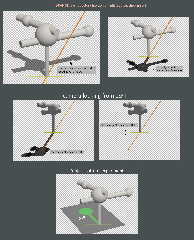|
 |
"Bald Eagle" <cre### [at] netscape net> wrote:
>
> ...the idea here is to use the object itself to create the fake shadow
> object, we need to deform it, to sort of fold it down flat to meet the ground
> plane.
> [snip] ...so we need to scale it very small in y to get the flattened shadow
> version that we want.
>
The ground plane? As in, horizontal?
Oh!!! [*** slaps forehead, and kicks self in butt**]
So the matrix-oriented object is horizontal! Or more precisely (using a y-scale
of plain old 1.0 for starters) that object is now aligned along the light's
direction vector, but 'flipped' through the origin and sheared a bit, thanks to
the -vnormalize vector and the matrix itself...and because y is your 'basis
vector' for the matrix. It's all suddenly clear to me-- one of those 'eureka'
moments. Thanks!
We Southern Walkers can be a bit slow-witted at times :-P
I originally thought the matrix object was still vertical(!) but simply sheared
left and down-- which is why I couldn't understand why it should be scaled in y.
The camera view and angle fooled me. But now the tiny y-scaling makes perfect
sense-- not only to 'flatten' the object, but to bring that flatness into very
close parallelism with the x/z plane, to look like a correctly-placed shadow.
I added a few different cameras/positions to see what was going on, and did some
simple animations while changing the scale. Very interesting! There is actually
a small *range* of y-scalings that gets rid of the intersecting-surface
artifacts, before the object completely disappears (which itself must be a
precision issue.) I'm thinking that if the object was made 100-1000 times
larger, rather than just 1-unit tall, the y-scale would probably not need to
be so exacting.
BTW, I eliminated the ground-plane object; it doesn't seem to serve a purpose,
and kind of gets in the way.
The one thing that still puzzles me is *why* the smaller and smaller y-scale
eliminates those intersecting-surface artifacts; seems that they should still be
there no matter how tiny the scaling is. Perhaps the happy result of a precision
issue again?
I also tried an 'object pattern' for the shadow (no matrix needed,
just the negative vnormalize trick): I pasted its created pigment on the front
of a vertical box, then aligned/rotated the box using
Point_At_Trans(<LS2.x,0,LS2.z> It works, sort of...but the object-pattern
operation is a bit odd (or rather, unexpected)-- the pattern seems to be derived
from an infinitely thin slice of its object in the x/y (?) plane-- which leaves
out any parts that do not overlap that plane:
#declare OBJ_PATTERN =
pigment{
object{Object
// translate (-.35 + .65*clock)*z // experiment
color rgb .2
color rgb .5*<.3,1,.3>
}
}
#include "transforms.inc"
box{<-.7,-.4,0>,<.7,1.6,.01> // vertical box centered on x-axis
texture{pigment{OBJ_PATTERN} finish{ambient 1 emission 0 diffuse 0}}
Point_At_Trans(<LS2.x,0,LS2.z>)
no_shadow
} net> wrote:
>
> ...the idea here is to use the object itself to create the fake shadow
> object, we need to deform it, to sort of fold it down flat to meet the ground
> plane.
> [snip] ...so we need to scale it very small in y to get the flattened shadow
> version that we want.
>
The ground plane? As in, horizontal?
Oh!!! [*** slaps forehead, and kicks self in butt**]
So the matrix-oriented object is horizontal! Or more precisely (using a y-scale
of plain old 1.0 for starters) that object is now aligned along the light's
direction vector, but 'flipped' through the origin and sheared a bit, thanks to
the -vnormalize vector and the matrix itself...and because y is your 'basis
vector' for the matrix. It's all suddenly clear to me-- one of those 'eureka'
moments. Thanks!
We Southern Walkers can be a bit slow-witted at times :-P
I originally thought the matrix object was still vertical(!) but simply sheared
left and down-- which is why I couldn't understand why it should be scaled in y.
The camera view and angle fooled me. But now the tiny y-scaling makes perfect
sense-- not only to 'flatten' the object, but to bring that flatness into very
close parallelism with the x/z plane, to look like a correctly-placed shadow.
I added a few different cameras/positions to see what was going on, and did some
simple animations while changing the scale. Very interesting! There is actually
a small *range* of y-scalings that gets rid of the intersecting-surface
artifacts, before the object completely disappears (which itself must be a
precision issue.) I'm thinking that if the object was made 100-1000 times
larger, rather than just 1-unit tall, the y-scale would probably not need to
be so exacting.
BTW, I eliminated the ground-plane object; it doesn't seem to serve a purpose,
and kind of gets in the way.
The one thing that still puzzles me is *why* the smaller and smaller y-scale
eliminates those intersecting-surface artifacts; seems that they should still be
there no matter how tiny the scaling is. Perhaps the happy result of a precision
issue again?
I also tried an 'object pattern' for the shadow (no matrix needed,
just the negative vnormalize trick): I pasted its created pigment on the front
of a vertical box, then aligned/rotated the box using
Point_At_Trans(<LS2.x,0,LS2.z> It works, sort of...but the object-pattern
operation is a bit odd (or rather, unexpected)-- the pattern seems to be derived
from an infinitely thin slice of its object in the x/y (?) plane-- which leaves
out any parts that do not overlap that plane:
#declare OBJ_PATTERN =
pigment{
object{Object
// translate (-.35 + .65*clock)*z // experiment
color rgb .2
color rgb .5*<.3,1,.3>
}
}
#include "transforms.inc"
box{<-.7,-.4,0>,<.7,1.6,.01> // vertical box centered on x-axis
texture{pigment{OBJ_PATTERN} finish{ambient 1 emission 0 diffuse 0}}
Point_At_Trans(<LS2.x,0,LS2.z>)
no_shadow
}
Post a reply to this message
Attachments:
Download 'fake_shadow_comp_kw.jpg' (528 KB)
Preview of image 'fake_shadow_comp_kw.jpg'

|
 |




![]()